
The BSA Bantam is a two-stroke unit construction motorcycle that was produced by the Birmingham Small Arms Company (BSA) from 1948 until 1971. Exact production figures are unknown, but it was over 250,000 and some estimates place the number closer to half a million.

A motorcycle engine is an engine that powers a motorcycle. Motorcycle engines are typically two-stroke or four-stroke internal combustion engines, but other engine types, such as Wankels and electric motors, have been used.

The Triumph Trident and BSA Rocket 3 was a technically advanced, high-performance roadster motorcycle made by Triumph Engineering and BSA from 1968 to 1975, and sold under both the Triumph and BSA marques. Alongside the Honda CB750, and later the Kawasaki triples, it brought a new level of sophistication to street motorcycles, marking the beginning of the superbike era. The Honda CB750 overshadowed the Trident to be remembered as the 'first superbike', in spite of the Triumph Trident actually debuting before the Honda by a few weeks.

Edward Turner was an English motorcycle designer. He was born in Camberwell in the London Borough of Southwark, on the day King Edward VII was proclaimed King. In 1915, Turner had his first ride on a motorcycle, a Light Tourist New Imperial.

Douglas Lionel Hele was a pioneering British motorcycle engineer with Triumph and other firms: BSA, Douglas and Norton. He was born in Birmingham in 1919 and died in Hagley, Worcestershire on 2 November 2001.

The BSA Golden Flash, commonly referred to as the Gold Flash, was a 646 cc (39.4 cu in) air-cooled parallel twin motorcycle designed by Bert Hopwood and produced by Birmingham Small Arms Company (BSA) at Small Heath, Birmingham. The Golden Flash was the first model in the BSA A10 series. It was available in black and chrome; but it was the distinctive golden paint scheme that gave The Golden Flash its name. Production continued until 1963, when it was superseded by the BSA A65 Star.

The BSA Rocket Gold Star (RGS) was a 646 cc (39.4 cu in) air-cooled parallel twin motorcycle produced by Birmingham Small Arms Company (BSA) at Small Heath, Birmingham. Launched in February 1962, it was one of the final range of A10 twins, using a tuned A10 Super Rocket engine in the double-downtube Gold Star frame.

The BSA Super Rocket was a 646 cc (39.4 cu in) air-cooled parallel twin motorcycle produced by Birmingham Small Arms Company (BSA) at Small Heath, Birmingham introduced in 1957. It was an improved sports bike member of the BSA A10 series of motorcycles which was developed from the BSA Road Rocket. The A10 had a reputation for reliability but was struggling to compete against the Triumph engines and the Norton Featherbed frames. The model was discontinued in 1963 when the unit-construction A65 was introduced.
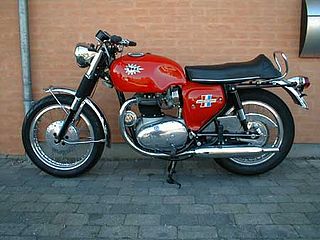
The BSA Spitfire was a high-performance BSA motorcycle made from 1966 to 1968 with model designations of MkII, MkIII and MkIV. Announced at the Brighton motorcycle show held during September 1965, it was based on the earlier BSA Lightning with a power-upgrade achieved by higher compression-ratio 10.5:1 pistons and two large-bore Amal GP carburettors with velocity stacks it was one of the first BSAs to have 12-volt electrics. At introduction in 1966, it was the fastest standard BSA ever produced and the fastest standard motorcycle tested by Motor Cycle with a best run at 123 mph and average of 119.2 mph The Spitfire was used for travelling Marshalls' course duties at the 1967 Isle of Man TT races.
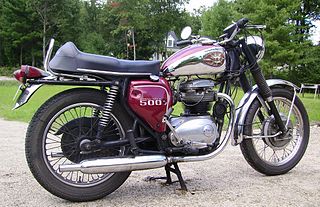
The BSA Royal Star was a Birmingham Small Arms Company (BSA) motorcycle whose new engine design paved the way for a range of successful unit construction twins. As well as giving a clean look to the engine, with the pushrod passages part of the cylinder block casting, unit construction reduced the number of places oil could leak from.

The BSA Lightning was a British BSA 650 cc-class motorcycle made in Birmingham between 1965 and 1972.
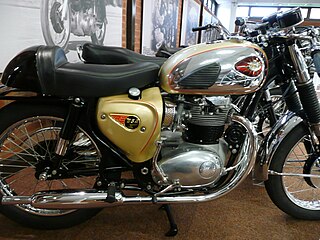
The BSA Lightning Clubman was a 650cc British motorcycle made by BSA at their factory in Birmingham between 1964 and 1965. Finished in gold and black the Lightning Clubman is now a highly sought after classic motorcycle. Due to the very limited production numbers replicas are created by enthusiasts from the BSA Lightning.

The TR6 Trophy is a motorcycle that was made by Triumph, in Meriden, from 1956 to 1973, when it was replaced by the five-speed 750-cc Triumph Tiger TR7V. During this time, it was a successful model, particularly in the US. The competition variant, popularly known as the "desert sled", won numerous competitions throughout the late 1950s and 1960s. Steve McQueen's fondness for the model is well known, as is his participation in the 1964 ISDT on a TR6 Trophy.

The BSA C15 was a 250 cc single-cylinder ohv motorcycle manufactured by the British company BSA from September 1958 until 1967, and was BSA's first four-stroke unit-construction bike. For most of that period, after the introduction of 'Learner Laws' in 1961, a 250 cc was the largest capacity solo machine that a learner could ride unaccompanied when displaying L-plates in the United Kingdom. A road-going Sports derivative was added in 1961, and off-road versions, for Trials and Scrambles, were also available in the range.
The BSA B50 was a single-cylinder 499 cc (30.5 cu in) ohv motorcycle, produced by BSA at their factory in Small Heath, Birmingham. The last of the big capacity unit-construction singles from the Birmingham Small Arms company, it had an alloy engine with a bore of 84 mm (3.3 in) and a stroke of 90 mm (3.5 in). As well as the road version, special models were produced for off-road competition use.
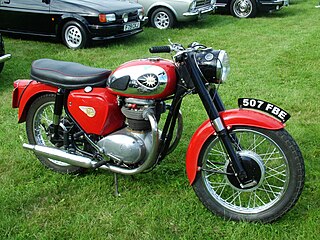
The BSA A65 Star was a Birmingham Small Arms Company (BSA) motorcycle aimed at the US market for unit construction twins. As well as giving a clean look to the engine, with the pushrod passages part of the cylinder block casting, unit construction reduced the number of places oil could leak from. A range of A65 Star twins was produced between 1962 and 1972.
The BSA A65R Rocket was one of a series of unit construction twin cylinder Birmingham Small Arms Company (BSA) motorcycles made in the 1960s. A version branded as the A65 'Thunderbolt Rocket' was aimed at the US market. The A65R Rocket was produced from 1964 but was stopped in 1965 when all development at BSA was halted by financial difficulties.

BSA motorcycles were made by the Birmingham Small Arms Company Limited (BSA), which was a major British industrial combine, a group of businesses manufacturing military and sporting firearms; bicycles; motorcycles; cars; buses and bodies; steel; iron castings; hand, power, and machine tools; coal cleaning and handling plants; sintered metals; and hard chrome process.
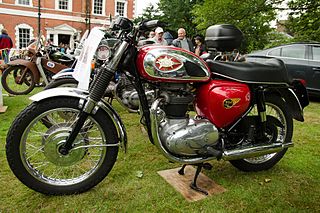
The BSA unit twins were a range of unit construction twin-cylinder motorcycles made by the Birmingham Small Arms Company (BSA) and aimed at the US market. A range of 500 cc (31 cu in), 650 cc (40 cu in) and 750 cc (46 cu in) twins were produced between 1962 and 1972, but they were really developments of the older pre-unit A7/A10 model range with less weight. The engines had a reputation for vibration, but acceleration was good for the time, to a top speed of 100 miles per hour (160 km/h).
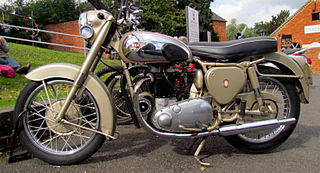
The BSA A10 series was a range of 646 cc (39.4 cu in) air-cooled parallel twin motorcycles designed by Bert Hopwood and produced by Birmingham Small Arms Company at Small Heath, Birmingham from 1950 to 1963. The series was succeeded by the A65 unit construction models.



















